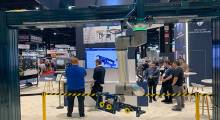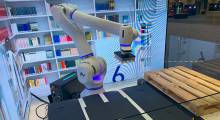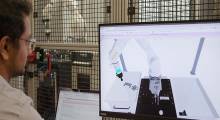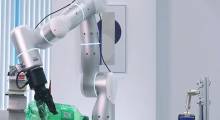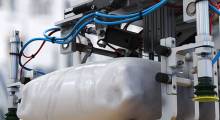Robots can do lots of things. Robots can do lots of things well. But when it comes to robots and multiple applications, things can potentially hit a snag.
Get a grip.
OnRobot started with grippers
OnRobot was founded in Odense, Denmark in 2018 after a merger of three end-of-arm tooling companies - On Robot, OptoForce and Perception Robotics. The company’s mission is to “break down automation barriers and bring the benefits of robotic automation to manufacturers of all sizes.”
OnRobot’s history is deeply rooted in robotic grippers. But by the end of 2022, the company took a step in the software direction with D:Ploy.
D:Ploy represents an “automated platform for building, running, monitoring and re-deploying collaborative applications,” according to the company. The hardware robot cell represents the integration point, or the D:Ploy brain that connects to the robot arm. The software portion of D:Ploy opens an expansive world of end-of-arm attachments for a myriad of applications.
“It was important for us as a company that we didn't want to be political or dictate what type of robot that any of the users would want to use, it's up to their preference,” said Kristian Hulgard, general manager of Americas at OnRobot. “We made sure that we had a software plugin for each robot operating system. This has been a massive R&D mission for us.”
D:Ploy is compatible with over a dozen different types of robot vendors, enabling end users to utilize the robot arms already at their organizations and incorporate the platform to maximize efficiency for various applications.
“We are in very close cooperation with the different robot manufacturers,” said Jesper Fuglsig, R&D director at OnRobot. “We understand their interface with the API between our grippers or D:Ploy. Together with them, we develop an interface between the two systems.”
Expedite deployment and redeployment time
It’s one thing to quickly deploy a robot for an application such as packaging, palletizing, picking or machine tending. It’s another to take the same robot and change the end-of-arm attachment for another application in a couple minutes.
“We have quick change technology where you can click the existing gripper off and click the new gripper on and that’s all I have to do from the end-of-arm tool perspective,” Hulgard said. “The rest is D:Ploy. It’s already powered on and ready to go.”

In the software platform, users are able to identify the robot brand, type of gripper, geographic space of the robot cell and utilize a template for a specific type of application in a matter of minutes. OnRobot has worked closely with its robot vendor partners to streamline the end user deployment process to a couple clicks in the D:Ploy platform, regardless of the application.
“The whole point of D:Ploy is that you can standardize an application, sell it and meet the demand of the market,” Hulgard said. “With the same amount of engineering hours, we can deploy 10 times as many robots as the traditional way of integrating.”
Standard grippers, with customizable features
“Our hardware, generally speaking, is standard products out of the box with customizable features,” Hulgard added.
Owing to its history as a gripper developer, OnRobot has a large toolbox of various electric and vacuum grippers that attach to the end of robot arms. Hulgard and Fuglsig said that most customers utilize the standard, off-the-shelf grippers that OnRobot has in its arsenal, but customization is an option.
“We’re experts in grippers,” Hulgard said. “Based on the shape, dimensions and the payload, we give customers a suggestion and put them in contact with our partners. They can get quoted and they can buy it. When we talk about D:Ploy, it promotes creating standard solutions with off-the-shelf automation that the integrators and distributors can sell to the customer.”
OnRobot grippers have been featured at the International Space Station and inside ice cream freezers, and in conjunction with vision sensors and force-torque sensors, robots deployed with D:Ploy can pick, palletize and pack a lot.
Future focuses on software updates, more standard hardware
As D:Ploy approaches its second year in the marketplace, OnRobot is continuing to integrate more hardware to its database. The company is also working with its customers to discover what new applications and features they want to incorporate into their offerings.
“Our partners and end customers say to us ‘What kind of new features do you need either for palletizing or CNC, for example,’” Fuglsig said. “There’s a lot of focus on bringing down the time you need to set up the first application in D:Ploy to the next application, that’s what the future is about. We really want to minimize the teaching you have to do when you have to move a robot because that’s time consuming and that’s what we try to get rid of.”
Hulgard agreed, emphasizing that the standard solution option from robot vendors has been on his mind for the past five years. And, he explained how the future will look with a lot more robots in the field.
“IFR predicts that we’ll see 10 times as many robots in the next five years,” Hulgard said. “How are we going to reach that number if we are not exponentially gaining more engineering hours? We have the same amount of engineers but we have to install 10 times as many robots. The only way you can do that is by minimizing the amount of time needed to install each robot. Standardized solutions and software like D:Ploy is addressing that issue by minimizing the amount of time and money needed to deploy a robot.”
Want to learn more about robots picking, packing and packaging? This article was featured in the October 2024 Robotics 24/7 Special Focus Issue titled “Robots picking and packing with precision.”
About the Author
Follow Robotics 24/7 on Linkedin
Article topics
Email Sign Up




